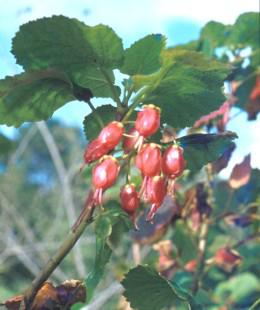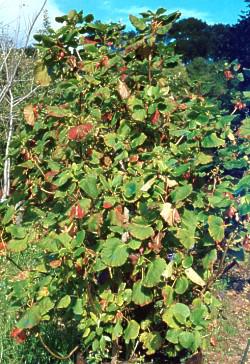Greyia flanaganii
Greyia flanaganii Bolus
Family: Melianthaceae
Common names: Kei bottlebrush (E), Kei baakhout (A), uSinga lwamaxhegokazi (X).
SA Tree No: 444
Introduction
Greyia flanaganii has great horticultural potential as a spring flowering shrub that is yet to be fully explored by growers and gardeners. This tree is growing in several botanical gardens associated with universities and botanic gardens in South Africa. In 1998 it was the Tree of the Year.

Description
Description
This is a stunning shrub or small, much-branched, evergreen tree that grows up to 3 m in height. The bark is smooth and pale brown. The leaves are ovate to almost circular and are crowded at the ends of the branches. The upper side of the leaf is grey-green to dark green and sparsely hairy, whereas the underside is pale green, heavily veined and densely hairy. The leaf margin is broadly scalloped and toothed, and usually slightly lobed.

Greyia flanaganii has showy, bright red, bell-shaped flowers in lax, few-flowered, downward-pointing racemes during spring (from August to October). Each flower is about 2 cm long with red stamens and style protruding from the mouth of the petal tube. The outer whorl of the stamens of this genus has lost its function of producing pollen and the stamens have been transformed into nectar glands. The nectar-rich flowers attract many insects such as honeybees, as well as pollinators like sunbirds. The fruits of this exciting shrub are 2.5 x 0.7 cm, brownish and cylindrical, and split along their inner surfaces to release the small seeds.
Distribution and habitat
Distribution description
Greyia flanaganii is one of three closely related species of the taxonomically isolated and endemic southern African family, the Greyiaceae. The other two species in the Greyiaceae family, Greyia radlkoferi and G. sutherlandii are dormant and leafless in winter, unlike G. flanaganii, which is evergreen. G. radlkoferi is found in Mpumalanga and Limpopo (Northern Province) and G. sutherlandii is from KwaZulu-Natal. The greyias of South Africa do not appear to have close relatives among the extant flora of the world. Steyn et al 1999 refer to a theory that greyias deserve to be placed in a separate order. Greyiaceae belongs in the monotypic order Greyiales that was formerly described and placed between the Saxifragales and Francoyales.
Derivation of name and historical aspects
History
The genus Greyia was named in honour of Sir George Grey, 1812-1898, who was the Governor of the Cape Colony in the second part of the 19th century. He was also a great patron of botany. The species was named after Henry George Flanagan, 1861-1919, a South African-born collector and traveller. Flanagan also owned Prospect Farm in the Komga District of Eastern Cape, where he developed a noteworthy garden containing rare exotics as well as South African trees and shrubs.
Ecology
Ecology
Greyia flanaganii is a rare endemic of Eastern Cape, where it is found on the grassy hillsides and among rocks on the steep slopes of the Kei River and its tributaries, the Toise and Kabusi Rivers. The seedlings are tiny and fragile. This may be the reason why these shrubs are often found emerging from fissures in rocks.
This plant is very frost tolerant. It remains evergreen even in areas exposed to frost in winter. It is very hardy and drought resistant. In cultivation, established plants will thrive in any soil type. Greyia flanaganii is well suited to small gardens, but it can also be used to good effect as a specimen plant in larger gardens.
Uses
Use
The Xhosa people place the roots of this Eastern Cape tree on either side of their kraals (enclosures) as it is thought to ward off sickness and prevent theft of livestock.
Growing Greyia flanaganii
Grow
Greyia flanaganii is relatively slow-growing, and is propagated from cuttings and seed. Softwood cuttings taken from leafy shoots and placed in a well-drained growing medium will root readily at any time of the year. Raising plants from seed is more challenging. It is best to sow freshly collected seed which has a germination rate of about 75%. Seedlings need a lot of care as they are fragile and should only be transplanted when they are quite large and have been hardened off.
References
- Coates Palgrave, K. 1983. Trees of southern Africa. Struik Publishers, Cape Town.
- Manning, J. 2001. Eastern Cape. South African wild flower guide 11. Botanical Society of South Africa & National Botanical Institute, Cape Town.
- Palmer, E. & Pitman, N.1972. Trees of southern Africa. Balkema, Cape Town.
- Pooley, E. 1993. Trees of Natal, Zululand and Transkei. Natal Flora Trust, Durban.
- Steyn, E.M.A. & Smith, G.F. 1998. Greyia flanaganii: Tree of the Year. Veld & Flora 84: 14, 15.
- Steyn, E.M.A, Smith, G.F. & Condy, G. 1999. Greyia flanaganii. Flowering Plants of Africa 56: 86-92.
- Steyn, E.M.A., Robbertse, P.J. & Van Wyk, A.E. Floral development in Greyia flanaganii with notes on inflorescence initiation and sympodial branching. South African Journal of Botany 53: 194-201.
Credits
Giles Mbambezeli
Kirstenbosch National Botanical Garden
October 2002
Plant Attributes:
Plant Type: Shrub, Tree
SA Distribution: Eastern Cape
Soil type:
Flowering season: Spring, Early Summer
PH:
Flower colour: Red
Aspect: Full Sun
Gardening skill: Average
Special Features:
Horticultural zones











Rate this article
Article well written and informative
Rate this plant
Is this an interesting plant?
Login to add your Comment
Back to topNot registered yet? Click here to register.